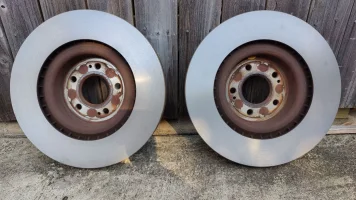tarmacblack1
Member
- Joined
- Jun 6, 2019
- Messages
- 83
- Reaction score
- 23
- Points
- 8
For those who have swapped out brake pads, did you have your rotors resurfaced ? I've just start getting the shudder at 12,500 miles. Thanks for any input.

I started having the pad deposit issue around the same time, getting aftermarket pads and doing the bedding in process with the new pads seemed to remove the deposits. No issues since, now at 25,000 miles.For those who have swapped out brake pads, did you have your rotors resurfaced ? I've just start getting the shudder at 12,500 miles. Thanks for any input.

I am in full agreement. I will take it into consideration. Probably be a last minute flip of a coin. Rotors look pretty damn healthy but I don't want shit running through the back of my mind lol.If the rotors had some miles on them, resurfacing with new brake pads is never a bad idea. Can you get away with not turning the rotors? Of course.
If my rotors show any scoring or grooving, of if they measure any taper (from inside to outside edge of friction surface), I will for sure get them turned, regardless of how many miles are on them. When I changed the brake pads last September, the rotors were very smooth and had no measurable taper, so I scrubbed off the pad material deposits and re-used them as is. Well, the rears did just fine, but the fronts were not happy. They made noise and pulsed whenever I push the brake pedal with a bit more pressure. Got them turned for $25/rotor - and voila! - smooth as silk.
It's a judgement call. If you do decide to skip resurfacing, I'd suggest you proceed with caution and take it easy, inspect the rotors after every drive, until you are absolutely sure the new pads have seated with the old rotors fully and drama-free. If you encounter any unhappy symptoms, remove the rotors ASAP and get them turned.
View attachment 77676

A good shop will take off just enough material to achieve a true surface. O'Reily's removed only 0.1-0.2mm from either side of mine.

In any case, the only time when resurfacing old rotors is not a good idea is if they are heavily heat-spotted. Then they are good only for the trash can.
Otherwise, throwing away perfectly re-usable rotors is just a plain waste of money. Properly resurfaced used rotors can be more thermally stable than green new rotors. Repeated heat cycling helps to relieve residue stress from the manufacturing/machining process.
I'm not sure I'm reading you correctly. Did you ask the shop to surface the rotors ONLY? Or to surface the rotor while changing to brand new aftermarket brake pads at the same time?so I am in this same boat. My AWD stinger is at 16K miles, and it has been vibrating/pulsing while braking the last few months. I took it to a safety inspection, and they said the brakes were almost out. These are OEM brakes, but I did take the car to an HDPE last year.
Knowing about this thread and the main rotor sticky, I asked one of the shops if they would resurface the rotors. he said no, the rotors are brembo spec and don't need to be. The issue is with the pads, getting new pads will fix the issue.
I am going to call a 2nd shop tomorrow and ask the same thing: If they will resurface the rotors. If not, I just replace the brakes (oem --> Hawks 5.0) and do the bed-in process as described in the sticky?

What does the bedding process consist of again ? Couple stops from 60 mph pumping the brakes. And then cruise without stopping ?I started having the pad deposit issue around the same time, getting aftermarket pads and doing the bedding in process with the new pads seemed to remove the deposits. No issues since, now at 25,000 miles.
I followed what they provided in the box/instructions.Pad manufacturer may have bed in procedures on their site or box. But usually it's something like getting up to about 60+mph hitting the brakes pretty hard but not hard enough to trip the ABS and with steady pressure until you hit about 20mph get back up to speed, repeat. Do it at least 3, 4...maybe 5 times basically enough to get everything pretty hot. When you're done with the procedure drive around without stopping and trying not to use the brakes until they're cooled off.
I’ll give that a try since. I have a set of ceramic brake pads from k8. I’ll just follow this procedure . ThanksPad manufacturer may have bed in procedures on their site or box. But usually it's something like getting up to about 60+mph hitting the brakes pretty hard but not hard enough to trip the ABS and with steady pressure until you hit about 20mph get back up to speed, repeat. Do it at least 3, 4...maybe 5 times basically enough to get everything pretty hot. When you're done with the procedure drive around without stopping and trying not to use the brakes until they're cooled off.
